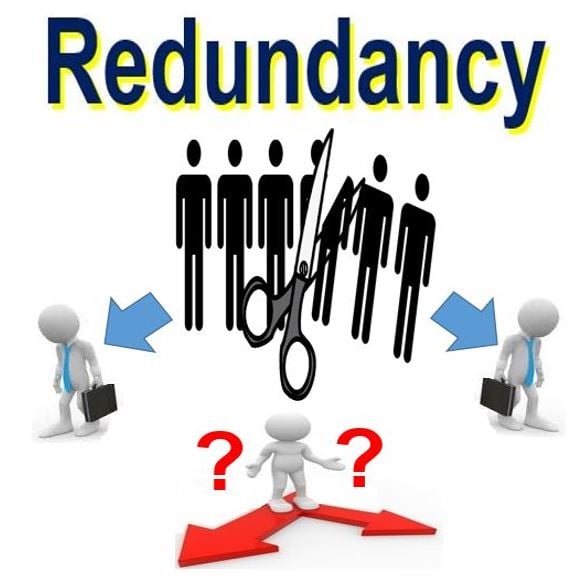Who Pays Redundancy Money? Comprehending Company Responsibilities in the UK
Who Pays Redundancy Money? Comprehending Company Responsibilities in the UK
Blog Article
Exploring the Interaction Between Firm Redundancy and Organizational Adaptability for Future Development
In the dynamic landscape of today's company world, the detailed connection between company redundancy and business adaptability arises as a critical element for continual development and success. Business typically face the difficulty of striking a delicate balance in between keeping a degree of redundancy to minimize threats and cultivating versatility to respond promptly to the ever-evolving market demands.
Importance of Firm Redundancy
Company redundancy is an essential element that improves organizational durability and alleviates functional risks. By incorporating redundancy steps within the organizational framework, firms can much better stand up to unpredicted interruptions and fluctuations in the organization environment. Redundancy works as a tactical buffer, enabling business to adapt and react successfully to unexpected challenges without compromising vital procedures.
One trick facet of the significance of firm redundancy is its role in making certain connection throughout times of situation. When confronted with unexpected changes or emergencies, repetitive systems, resources, or employees can action in to maintain essential functions and protect against prevalent disturbances. This continuity not just safeguards the company's track record and customer trust fund yet additionally reduces economic losses and functional downtime.

Approaches for Business Adaptability

Producing adaptable business frameworks that enable for quick modifications to market dynamics and customer needs is essential for remaining affordable in a quickly evolving atmosphere. By proactively recognizing potential disturbances and possibilities, companies can proactively adapt and flourish in an ever-changing company landscape.
Balancing Redundancy and Flexibility
Accomplishing an unified equilibrium in between operational redundancy and organizational flexibility is critical in browsing the intricacies of a dynamic organization environment. Striking the ideal equilibrium between redundancy and versatility is a fragile process that needs a deep understanding of the company's objectives, industry characteristics, and threat tolerance.
To achieve this balance, companies need to carry out routine analyses of their procedures to determine locations where redundancy is needed for threat reduction and where flexibility can drive technology and development. Implementing useful reference flexible structures, fostering a culture of continual knowing and enhancement, and motivating open communication across all levels of the organization are key techniques to harmonize redundancy and adaptability effectively. By aligning these 2 essential elements, firms can place themselves for lasting growth and success in an ever-changing company landscape.
Case Studies on Adjustment Success
In examining circumstances of effective organizational adaptation, it becomes noticeable that the interaction between operational redundancy and flexibility is a specifying consider shaping resistant services. One compelling study is that of Netflix. At first a DVD rental solution, Netflix demonstrated remarkable flexibility by transitioning right into a streaming system when digitalization interrupted the industry. By strategically purchasing innovation and content production, Netflix not just endured however thrived in a quickly developing market. An additional visit our website standout example is Amazon. Beginning as an online book shop, Amazon continuously adjusted its company version, broadening right into diverse fields such as cloud computing and fabricated intelligence. This versatility enabled Amazon to stay in advance of rivals and satisfy transforming consumer needs. Lastly, Adobe supplies a noteworthy picture of effective adjustment. The business changed from selling software application licenses to a subscription-based model, guaranteeing reoccuring income streams and boosted consumer engagement. These study underscore the importance of functional redundancy paired with organizational versatility in cultivating lasting growth and competitiveness.
Building Strength for Future Development
Building strength for future development requires a strategic placement of operational procedures with market dynamics and emerging patterns. Companies have to adjust to changing settings by promoting a society of versatility, innovation, and continual improvement.
In addition, promoting solid connections with stakeholders, such as clients, workers, distributors, and the neighborhood, is vital for weathering uncertainties and keeping trust and assistance throughout rough times. Reliable interaction and transparency play an essential function in structure resilience, as they assist facilitate and line up assumptions collaboration in navigating uncertainties.
Moreover, companies need to prioritize discovering and development initiatives to upskill workers and outfit them with the required tools to adjust to transforming circumstances. By purchasing their labor force, firms can enhance their versatility and dexterity, inevitably strengthening their resilience for sustainable future development.
Verdict

In the dynamic landscape of today's organization world, the detailed relationship in between company redundancy and organizational flexibility emerges as a critical element for sustained growth and success. Business usually encounter the difficulty of striking a delicate equilibrium in between maintaining a level of redundancy to alleviate threats and cultivating flexibility to react quickly to the ever-evolving market demands.To achieve this balance, business need to perform regular analyses of their procedures to recognize areas where redundancy is essential for threat mitigation and where versatility can drive technology and growth.In conclusion, the interplay in between firm redundancy and organizational adaptability is vital for future development. Structure strength through a combination of redundancy and versatility will make sure that firms are prepared for the obstacles of the future.
Report this page